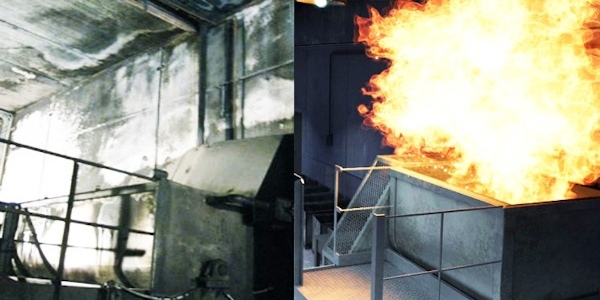In 2010, an explosion and fire occurred at the AL Solutions plant, which processed titanium and zirconium. Both metals in the form of dust are explosive. At elevated temperatures, they can react with water, additionally generating explosive hydrogen. For this reason, type D extinguishing powders are recommended. Nevertheless, four audits carried out over several years by consulting and insurance companies did not indicate that the water spraying system used in the plant constitutes an inappropriate extinguishing method. This example shows the continuing need to spread knowledge in the field of explosion and fire safety.
Some of these audits also praised the method of cleaning up the remaining dust by flushing them with a water jet. Although metals over time are covered with oxides, which normally make it difficult to react with water, at AL Solutions we have had to deal with a freshly ground material that has not yet formed such a protective barrier. As research has shown, a small amount of hydrogen is generated in this situation, increasing the energy of the dust explosion.
The production process at Al Solutions
At the AL Solutions production plant, titanium and zirconium waste was processed. The production process consisted of grinding these metals into dust, which was then separated into two fractions. The mesh fraction was returned to the grinding process or treated as waste. In turn, the fine powder was mixed and then pressed into blocks. The production was performed 24 hours a day for 7 days a week.

Photo. 1: Dust mixer in which the explosion occurred. On the left, a picture after the explosion; on the right, a visualisation.
Causes of dust explosion in the mixer and fire
Interviews with employees conducted after the explosion revealed that the plant had worked for a long time with a mixer where the blades rubbed against the housing. The information from the employees was confirmed by the local inspection, which revealed clear abrasions on the housing of the mixer.

Photo. 2: Traces of abrasions on the walls of the mixer in which the first explosion occurred.
As it turned out, the problem with the mixer had been present for a long time. Several attempts were made to fix it, but the actions taken were provisional so that the defect reoccurred quickly.
The day before the explosion, one of the employees again reported to the service that the mixer blades were hitting the housing. The service technicians adjusted the blades to solve this problem, thus increasing their distance from the device walls. This action proved to be ineffective, so the problem reoccurred quickly.
Next, the service technicians dismantled the shaft with blades in order to replace worn parts. It turned out the shaft had deep abrasions, which probably constituted the cause of the device’s improper operation. In addition, an oblong hole of about 25 cm was noticed in the mixer housing. The service technicians could not repair the shaft, so their work was limited to welding the device’s housing.
The next morning, the maintenance employee asked the service to replace the worn blades. One of the service technicians dismantled the old device’s blades and then installed them in the damaged mixer. It was only two hours before the explosion.
Effects of explosion and fire
On 9 December 2010, a zirconium dust explosion occurred in a non-operational mixer. The pressure and flame entered the hall through the cover of the device. This caused the dust to rise into the air, which was also ignited. There was a secondary explosion that spread to the plant, killing three people.
The fire that followed the explosion completely destroyed the plant. Among other things, equipment and zirconium barrels had ignited. – At this point, it should be emphasised that according to the internal guidelines of AL Solutions, the production hall should contain only as much raw material as is currently required for the actual process. However, the photographic documentation created after the event showed that many more barrels with raw material were stored in the hall than required.

Photo. 3: A large amount of raw material that was fuel for the fire.
Explosion protection — selected actions taken by AL Solutions
After the explosion, the investigation showed that AL Solutions took some measures to reduce the risk of explosion. However, they were patchy or ineffective. For example:
- Titanium and zirconium were tested for explosiveness. Although tests have shown that both products are explosive, adequate explosion protection, i.e., relieving, suppressing, and decoupling of the explosion, was not applied at the plant.
- AL Solutions developed a document describing procedures for the safe storage and processing of titanium and zirconium, which, however, were not enforced.
- Equipment that could release dust into the hall should be tightly closed — however, this requirement was not enforced.
- The company’s internal standard required that only the amount of flammable metals should be present in the production building that are required by the current process. However, this requirement was not enforced.
- The plant used water spray systems, even though explosive hydrogen can be generated by water during the extinguishing of zirconium and titanium fires. For extinguishing metal fires, type D powders are required.
In addition, AL Solutions management had implemented procedures to reduce the facility’s fire and explosion risk. Operators used non-sparking tools and wore clothing made of 100% cotton — these measures were aimed at reducing the risk of mechanically generated sparks and the occurrence of electrostatic discharges. The use of fire in the building was banned, and smoking was only allowed in a separate area outside the production zone. Electrical equipment, including motors located in the production building, has been designed not to constitute a source of ignition.
Photos www.csb.gov





